Sheikh Abd el-Gurna (Egypt)
Explorations in the hermitages in tombs 1151 and 1152 in the 2010-2011 season
Digging dates: 27 October 2010 – 24 January 2011
Team:
Tomasz Górecki, archaeologist, director of the mission (National Museum in Warsaw)
Dr. Anna Boud’hors, papyrologist, coptologist ( Institut de Recherche et d`Histoire des Textes – CNRS, Paris)
Patryk Chudzik, archaeology student (University of Wrocław)
Katarzyna Danys-Lasek, archeologist-ceramologist (freelance)
Assist. Prof. Tomasz Derda, papyrologist (Institute of Archaeology, University of Warsaw)
Julia Górecka, archeology student (Institute of Archaeology, University of Warsaw)
Christiane Hochstrasser-Petit, ethnoarchaeologist (freelance)
Dominik Kaletta, geophysicist (freelance)
Jarosław Majewski, geophysicist (freelance)
Zbigniew Polak, archeologist (Institute of Archaeology, University of Warsaw)
Roman Stasiuk, photographer (Academy of Fine Arts in Warsaw; National Library, Warsaw)
Anna Thomee-Stachoń, conservator (Polish Ateliers for Conservation of Cultural Property, Warsaw–Toruń)
Maciej Trzeciecki, archaeologist (Institute of Archaeology and Ethnology, Polish Academy of Sciences)
Piotr Zambrzycki, conservator (Academy of Fine Arts in Warsaw)
The work on site focused on completing the documentation of finds from previous seasons. Limited excavations verifying various research ideas were carried out inside the two hermitages as well as on the rocky slope below the courtyard of the tomb/hermitage 1152.
1. Archaeological research
The excavations concentrated on clearing two wadis observed to run from the courtyard of tomb/hermitage 1152 all the way down to the bottom of the slope facing east. As anticipated, the fill of the two wadis produced large quantities of Coptic pottery which had been swept out of the rubbish dump in front of the hermitage and transported down with the rainwater. In many instances, the finds from the wadis will complement vessels found previously in the dump, thus leading to a fuller reconstruction of many pottery forms. Interestingly, the wadi assemblage yielded a set of fine small bowls and cups coated in apparently careless manner with a beige-white-yellow slip. This group had been almost completely absent from the rubbish dump.
The southern of the two wadis also produced a damaged, but still intact mummy, most likely of pre-Coptic date, lying directly on top of the rock rubble. It is to be assumed that the mummy had been discarded from a robbed tomb at an unspecified time.
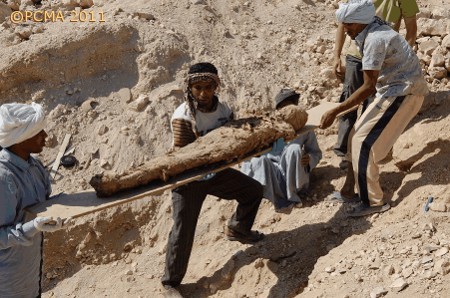
In the other tomb/hermitage 1151 the interior that had served as a chapel was now cleared completely. Inside this chamber there was a shaft which had been excavated in the 1920s by H. Winlock. Brick benches were uncovered in the southeastern corner as well as a mud floor laid by the Coptic monks directly on the rock floor of the tomb. The benches were coated with good hard polished lime plaster. The wall above a niche cut in the rock on the south side of the chamber bore evidence of decoration, illegible unfortunately, executed in red paint. The niche must have served a utilitarian function as its floor was finished with the same mud plaster as some of the walls.
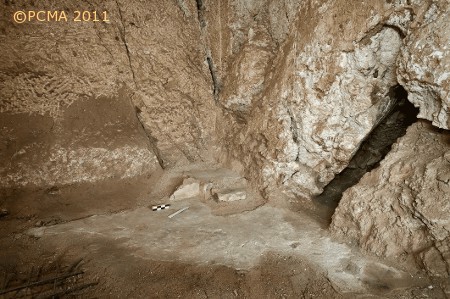
The mission also reexcavated a unit already cleared once by Winlock to the north of the entrance to tomb 1151. This proved to be a rock-cut hollow, 2 by 3 m in size, but with no remaining evidence of the purpose it had served. It may have been a grave from the Late Period or else a kind of storage bin used by the Coptic monks.
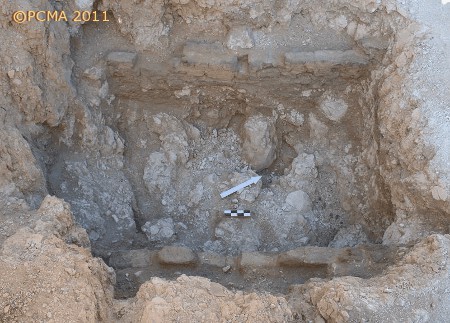
2. Ceramological studies
Studies concentrated on working through the pottery collected over the course of excavations from 2003 until 2009. The selection produced results in the form of several dozen recomposed vessels, chiefly tableware of Late Roman type, containers of both baked and dried clay, water bottles and cooking pots. The Late Roman assemblage in particular proved noteworthy, providing the opportunity to set chronological limits on the occupation of the hermitage in Coptic times.
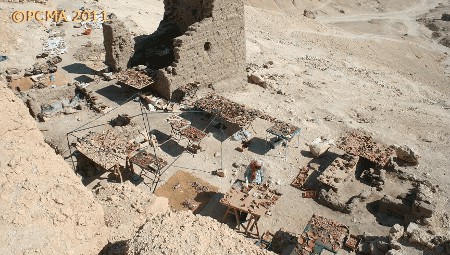
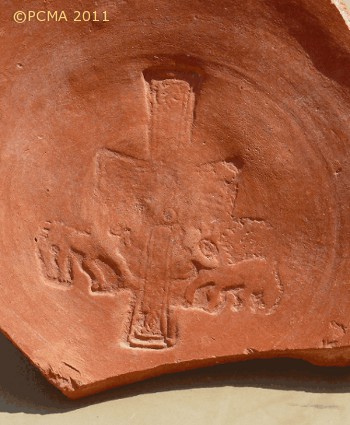
3. Verification of Coptic texts on ostraka
A provisional classification of written documents, which was established, has distinguished a few basic groups: letters, official documents, receipts, prayers and exercises. Examination of ostraka content has confirmed the results of archaeological and ceramological research, indicating two phases of occupation for the hermitage, the first from the middle of the 6th to the middle of the 7th century and the second in the first half of the 8th century.
4. Conservation
Leather objects discovered in 2003 were now cleaned and conserved. These objects included hides, tongs, parts of clothing and footwear. The folded hides were unfolded, giving the opportunity for identifying species and size. All of the hides came from young ovicaprids. The quality of the biggest tanned hide suggests a possible intention to use it for book binding rather than any other purpose. This conclusion is in keeping with what has already been determined regarding the nature of the craftswork done by the monks living in the hermitage in the 8th century, namely, codex binding.
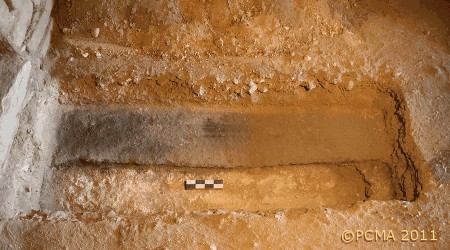
[Text T. Górecki]
[Polish language version of this report available at http://www.pnnarchiwum.uw.edu.pl/index.php?p=6&idm=153]
